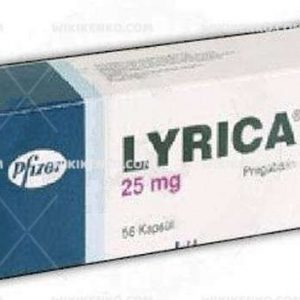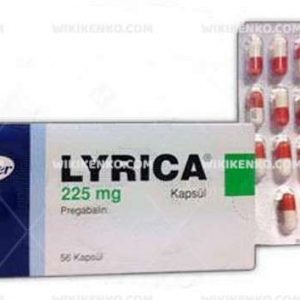Lyrica Capsule 75 Mg
Exploring the multifaceted realm of Lyrica, or pregabalin, unveils a medication renowned for its efficacy in treating diverse conditions, including epilepsy, neuropathic pain, and Generalized Anxiety Disorder (GAD)1. Administered in capsule form, this oral medication stands as a cornerstone in various therapeutic strategies3.
| Dosage form | |
|---|---|
| Pack size | |
| Potency | 75 Mg |
| Manufacturer | (Pfizer – Almanya) |
| Origin | Germany |
| Generic Name (Ingredient) | Pregabalin 75 Mg |
Assuming your emergency circumstances for this product, visit Urgent Quotation page. Besides, for any pharmaceutical questions, please ask us in the comments section.
Description
Uses of Lyrica Capsule 75 Mg
Neuropathic Pain
Lyrica emerges as a potent combatant against persistent neuropathic pain, a consequence of nerve damage often associated with conditions such as diabetes or shingles. The nuanced nature of this pain encompasses sensations ranging from heat and burning to tingling, numbness, and sharp or cramping pain.
Epilepsy
In the realm of epilepsy, Lyrica finds its role as a crucial adjunctive therapy for partial seizures with or without secondary generalization. It assumes significance when conventional treatments fall short, requiring a collaborative approach with existing therapeutic interventions.
Generalized Anxiety Disorder (GAD)
Lyrica extends its reach to address the complexities of Generalized Anxiety Disorder, alleviating symptoms of prolonged anxiety, restlessness, fatigue, difficulties concentrating, and sleep disorders. Its role in GAD underscores its versatility in psychiatric applications.
Composition
At the core of Lyrica lies the active substance pregabalin, complemented by components such as printing ink, shellac, black iron oxide (E172), propylene glycol, and potassium hydroxide. This intricate composition contributes to the medication’s efficacy and tolerability.
Warnings
Lyrica, while a therapeutic ally, necessitates an awareness of potential warnings. These include the risk of severe allergic reactions, the emergence of suicidal thoughts, and considerations for those with diabetes or heart issues. Abrupt discontinuation is cautioned to avoid withdrawal symptoms.
Overview
| Aspect | Information |
|---|---|
| Generic Name | Pregabalin |
| Administration | Oral |
| Uses | Neuropathic pain, epilepsy, generalized anxiety disorder |
| Composition | Pregabalin, printing ink, shellac, black iron oxide, propylene glycol, potassium hydroxide |
| Warnings | Severe allergic reactions, suicidal thoughts, caution in diabetes and heart issues, no abrupt discontinuation |
Side Effects
Lyrica’s spectrum of side effects spans from common occurrences to rare manifestations, necessitating attention and medical consultation.
Serious Side Effects
Less common but critical side effects encompass chest pain, cold sweats, muscle aches, seizures, and respiratory issues. Vigilance is paramount, as these may require immediate medical attention.
Rare Side Effects
Infrequent but noteworthy side effects include blistering, swelling, chills, joint or muscle pain, and red skin lesions. A nuanced understanding of these rare manifestations aids in comprehensive patient care.
Common Side Effects
More prevalent side effects, such as blurred vision, burning or tingling sensations, and coordination issues, often diminish during treatment. Monitoring and addressing these contribute to a patient’s overall well-being.
Onset and Missed Doses
Lyrica’s onset within the first week of therapy1 signifies its efficiency, with a Tmax of less than or equal to 1 hour for doses up to 300 mg. Individual variations exist, emphasizing the importance of consistent use guided by healthcare professionals.
In the event of a missed dose, adherence to healthcare provider instructions is paramount. Doubling doses is discouraged, highlighting the need for a systematic approach to dosage and timing.
Alcohol Interaction
The convergence of Lyrica and alcohol, both central nervous system depressants, demands cautious consideration. Their interaction intensifies sedation, dizziness, and coordination impairment, leading to potential risks such as respiratory depression.
Pregnancy and Breastfeeding Considerations
Pregnancy
Lyrica’s use during pregnancy requires a meticulous benefit-risk analysis, considering limited studies and potential fetal risks. Effective contraception is advocated, acknowledging the need for informed decisions in consultation with healthcare providers.
Breastfeeding
While breastfeeding and pregabalin exposure show low milk levels, cautious consideration is urged. Alternatives may be preferred, particularly when nursing newborns or preterm infants. The potential risk of tumorigenicity accentuates the need for personalized discussions with healthcare providers during breastfeeding.
Conclusion
In the intricate landscape of Lyrica Capsule 75 Mg, efficacy converges with complexity. From its versatile applications to the nuances of side effects and interactions, this medication demands a nuanced approach. The collaborative dialogue between healthcare providers and patients remains pivotal for optimizing outcomes. As Lyrica continues to stand at the intersection of medical science and patient-centered care, a comprehensive understanding ensures informed decisions and enhanced well-being.
Use the form below to report an error
Please answer the questions as thoroughly and accurately as possible. Your answers will help us better understand what kind of mistakes happen, why and where they happen, and in the end the purpose is to build a better archive to guide researchers and professionals around the world.
The information on this page is not intended to be a substitute for professional medical advice, diagnosis, or treatment. always seek the advice for your physician or another qualified health provider with any questions you may have regarding a medical condition. Always remember to
- Ask your own doctor for medical advice.
- Names, brands, and dosage may differ between countries.
- When not feeling well, or experiencing side effects always contact your own doctor.
Cyberchondria
The truth is that when we’re sick, or worried about getting sick, the internet won’t help.
According to Wikipedia, cyberchondria is a mental disorder consisting in the desire to independently make a diagnosis based on the symptoms of diseases described on Internet sites.
Why you can't look for symptoms on the Internet
If diagnoses could be made simply from a textbook or an article on a website, we would all be doctors and treat ourselves. Nothing can replace the experience and knowledge of specially trained people. As in any field, in medicine there are unscrupulous specialists, differences of opinion, inaccurate diagnoses and incorrect test results.






Reviews
There are no reviews yet.